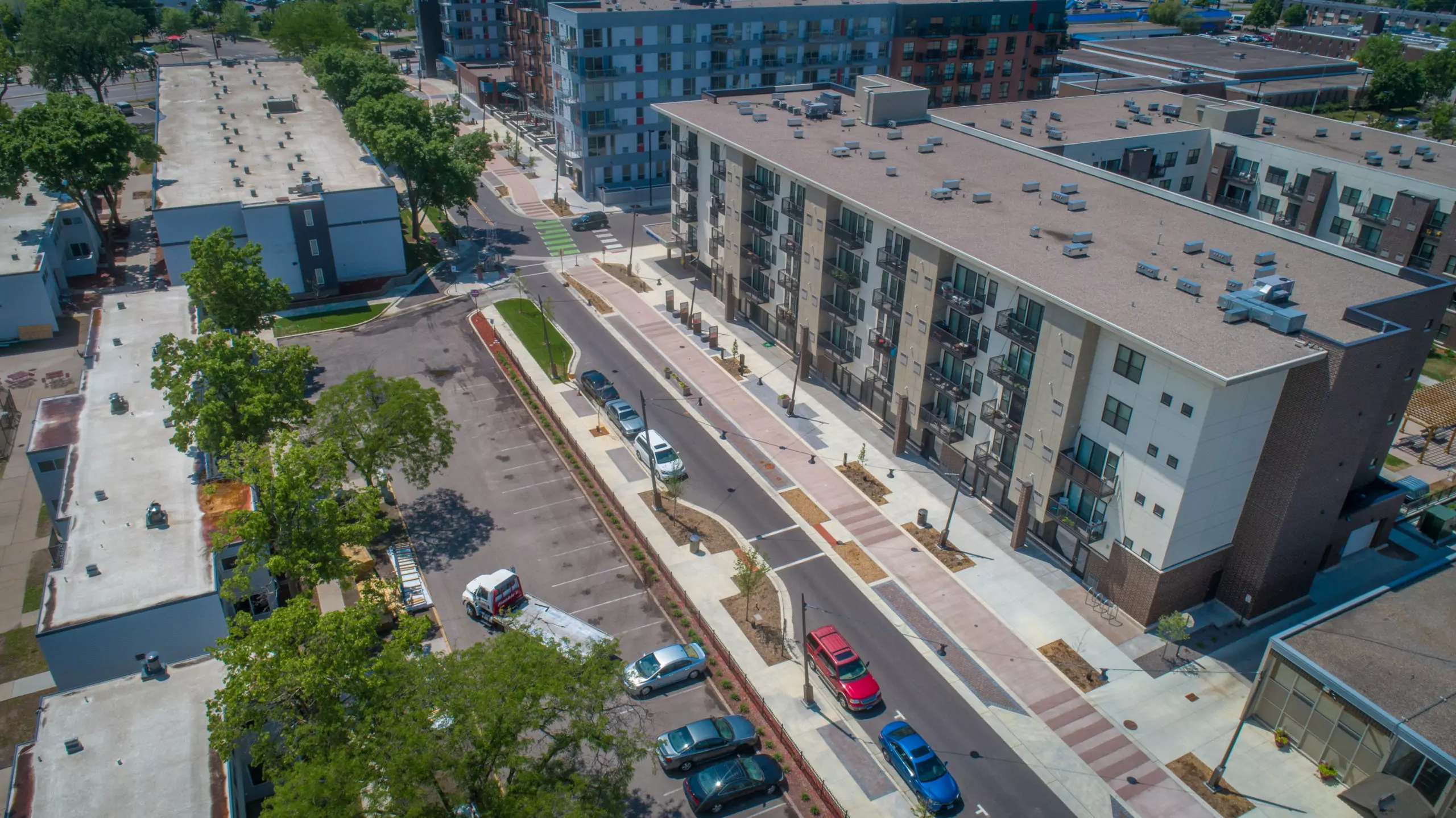
Hopkins’ Featured in Industry Magazine
The concept of the “Artery,” in Hopkins, Minnesota, as a potential gateway connection between Excelsior Boulevard and the Historic Downtown Mainstreet began with the Hopkins Planning and Economic Development Department in 2008. The need for action reached a tipping point in 2014 when the Southwest Light Rail Transit System (SWLRT) unveiled plans for an extension of the Twin Cities commuter network that would establish a station in Hopkins at 8th Ave. South and Excelsior Boulevard. News of the ‘Green Line’ served as a ‘call for action’ for the city to ensure that a safe north-south connection was available for pedestrians, bicyclists, bus riders, and motorists traveling to and from the proposed light rail station and Downtown Hopkins.
Community Driven Design
Bolton & Menk, a landscape architecture and engineering firm based in Mankato, Minnesota, was hired to “conceptualize, design, and develop a corridor to improve connections for vehicles, pedestrians, and bicyclists that would bring neighbors together and strengthen the bonds of the diverse community.” The project’s multi-faceted development process brought out a truly collaborative, multi-disciplinary effort: from economic development and planning professionals, engineers, landscape architects, bicycle advocates, public artists, contractors, and many other specialists. The firm believes few other projects challenge us to think differently about our problems and consider a diverse range of perspectives while creating something unique and successful on multiple fronts.
Building project support was a challenge as it required business and property owners along 8th Ave. South to adjust their travel routes. Extensive community engagement and attentiveness to project design were employed to gain public consensus. Many techniques were integrated to garner communal appreciation, but the city-led tactical urbanism activity, “The Artery Experiment,” cemented community support for this unique project. This public event introduced residents and visitors to a hands-on introduction of the city’s vision with a temporary installation mimicking the proposed Artery design. Guests experienced the separated two-way cycle track, modified traffic patterns, and creative gathering spaces filled with public art activities. More importantly, the city was able to demonstrate their vision of making the Artery a prime destination along the proposed SWLRT Green Line.
Local Artists Influence Design
The City of Hopkins commissioned local artists to work with the Bolton & Menk designers throughout the planning and construction process. This integration brought forth opportunities for placemaking within the Artery that pulls patrons from one area to the next as they experience the corridor.
The 8th Ave. South and Excelsior Boulevard intersection is a key design element that required considerable collaboration between Hennepin County, SWLRT, Three River Trails, and the City of Hopkins. Working jointly the team was able to incorporate artistic gateway features along with intersection modifications. Placement of the sculptural elements were carefully orchestrated to provide direct connections while prioritizing pedestrain safety along the street and in intersections.
Gathering spaces along the corridor called ‘Art Rooms’ were identified as a way to establish visual nodes that pull visitors through the area. These rooms were intentionally designed to accommodate changing art installations; helping to keep the corridor fresh. Caulk Art, Forever Ending Photo Opportunity (by Ben Zamora), Outdoor Art Gallery, Edible Garden, and Green Infrastructure Rooms attract curious pedestrians in every room.
A pedestrian plaza designed for large groups and organized gatherings is situated near the center of the corridor. This plaza extends across the road using a raised tabletop and changing surface material to signify the special use area. The installation of the ‘Night and Day’ sculpture acts as an anchor by drawing people along the corridor. Above the structure, constellations are carefully cut into the overhead disc, casting shadows on objects below. The sense of place is intimate, yet inviting, as it opens to the sidewalk and is tucked into the streetscape and screened from the adjacent parking lot.
Flexibility and Innovation
Community input directly impacted overall corridor design and established a partnership with Three Rivers Park District to close the gap between two regional trails and create a safe cyclist connection with a separated two-way cycle track. This connection features a lightly colored concrete surface with stainless steel medallion lane markers providing a visual delineation between public walk areas and the track. At all road and driveway intersections, contrasting colored concrete warning bands were installed in lieu of paint to reduce maintenance. At signalized intersections, FHWA gave experimental approval for a new signal that provides cyclists a leading green phase before vehicles receive a green.
The northern block of the Artery is designed as a one-way street and was constructed for temporary closures during special events. Standard curb and gutters were omitted from the western edge of the vehicle drive lane. Consequently, a ribbon curb with pervious pavers, movable planters, and infiltration gardens buffer the roadway from the cycle track and sidewalk. Removing the curb allows the Artery to accommodate full pedestrian access of the road, cycle track, and sidewalk during special events.
Environmental/Sustainable Design Techniques
Investment in the Artery positioned the 8th Avenue corridor and surrounding downtown as a model for sustainability. Though the project did not require permanent stormwater management, the city wanted to position Downtown Hopkins for redevelopment opportunities by integrating sustainable techniques and materials into the corridor. To meet this goal, the city partnered with the Nine Mile Creek Watershed District (NMCWD) to develop the first stormwater management credit bank in the history of NMCWD. This bank created credits available for purchase by adjacent future redevelopment projects.
Techniques used for stormwater management include a linear infiltration boulevard incorporated along the Artery that consists of infiltration gardens and permeable pavers between the curb line and cycle track. A “green infrastructure room” was incorporated as an educational art room, integrating sustainable practices of infiltration basins, stormwater tree trenches, drought-tolerant plant selections, and permeable pavers. Within the art room, interpretative panels encourage sustainability and provide educational narratives on stormwater management techniques for the public along with ‘take it home’ ideas of sustainability on a residential scale. The green infrastructure room was constructed in a highly visible area to bring the project’s sustainable approaches to the forefront.
